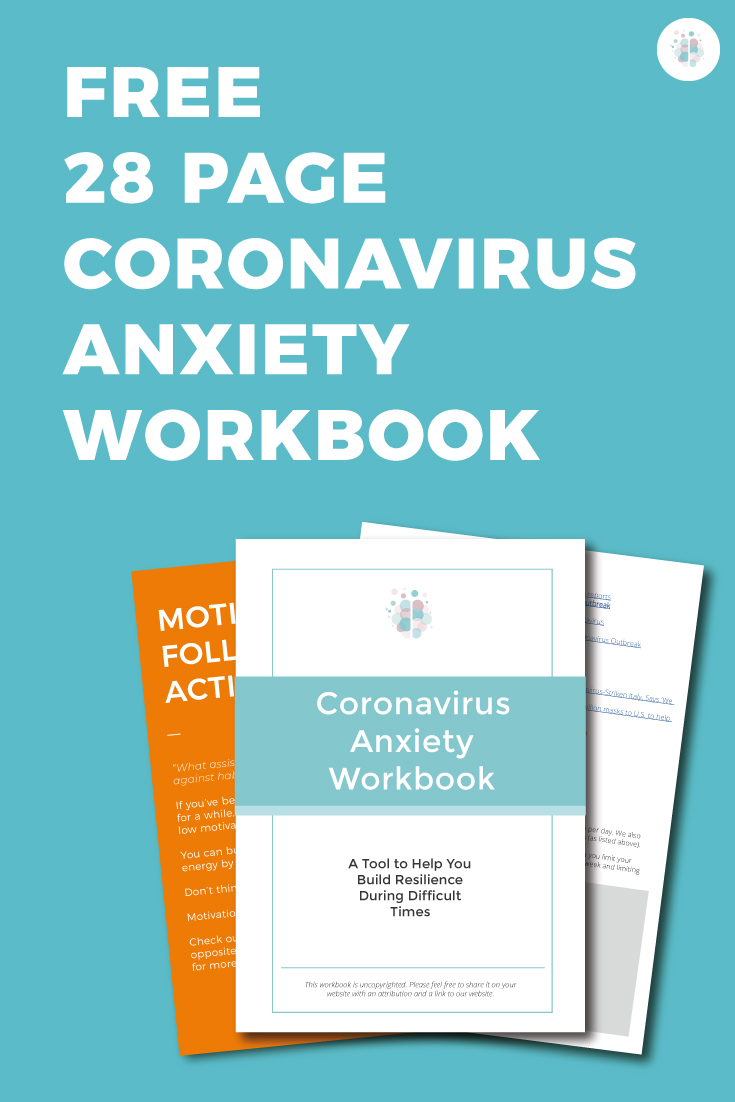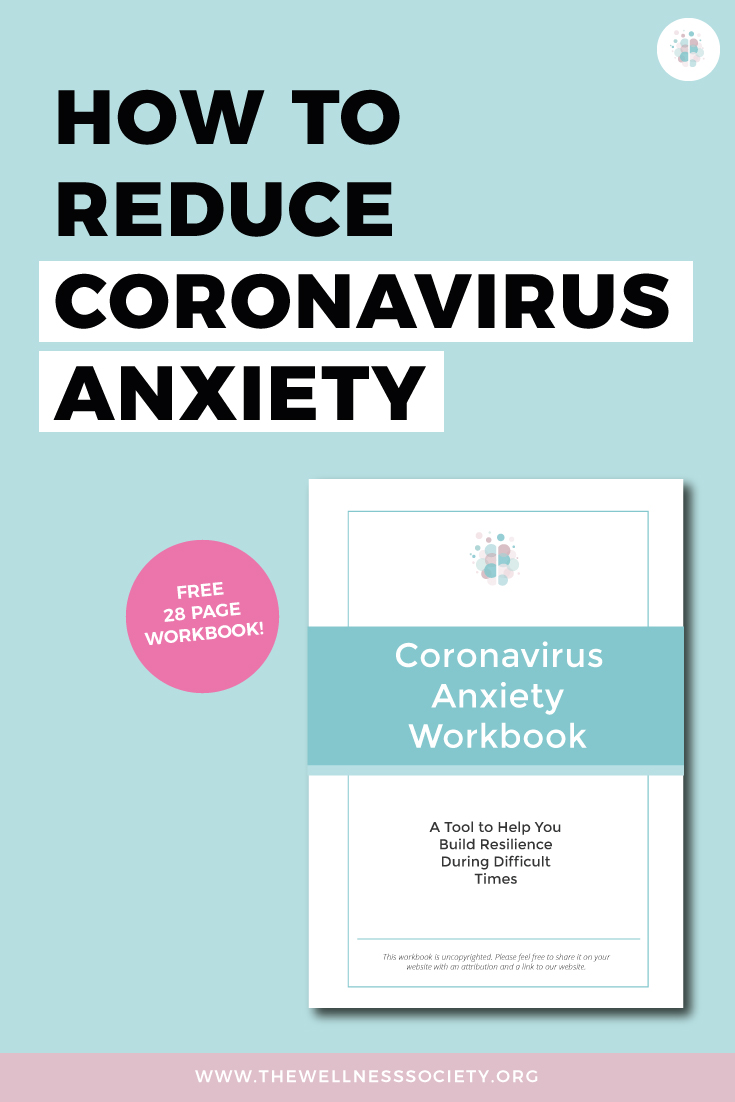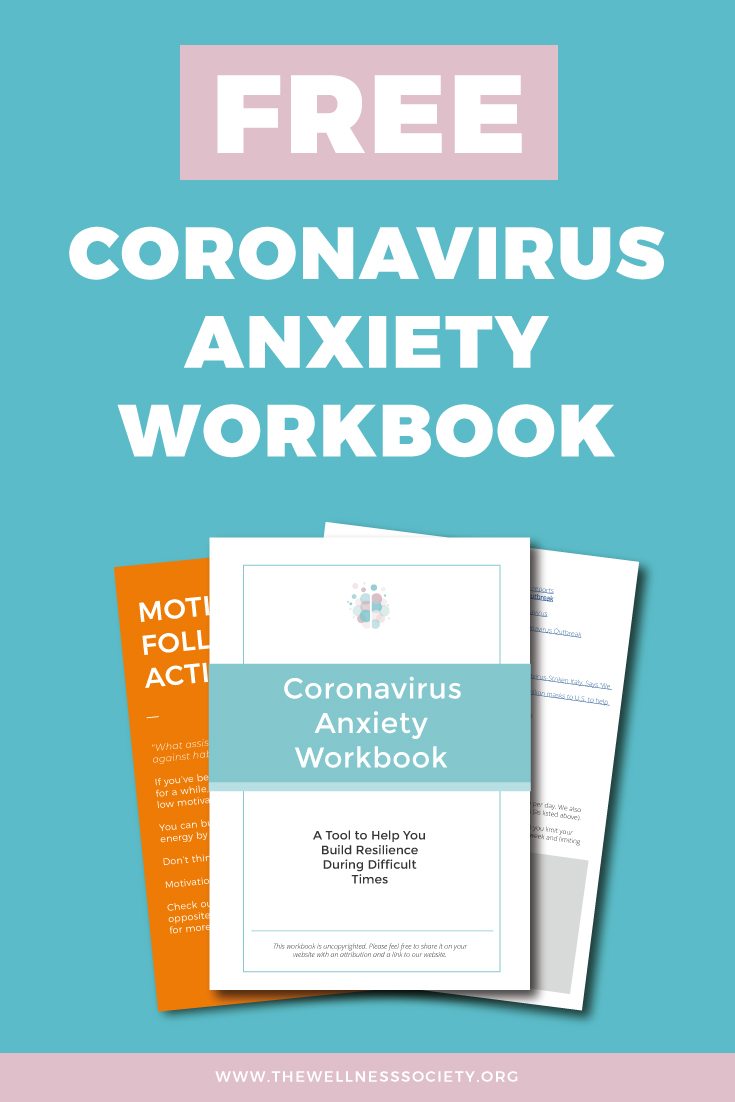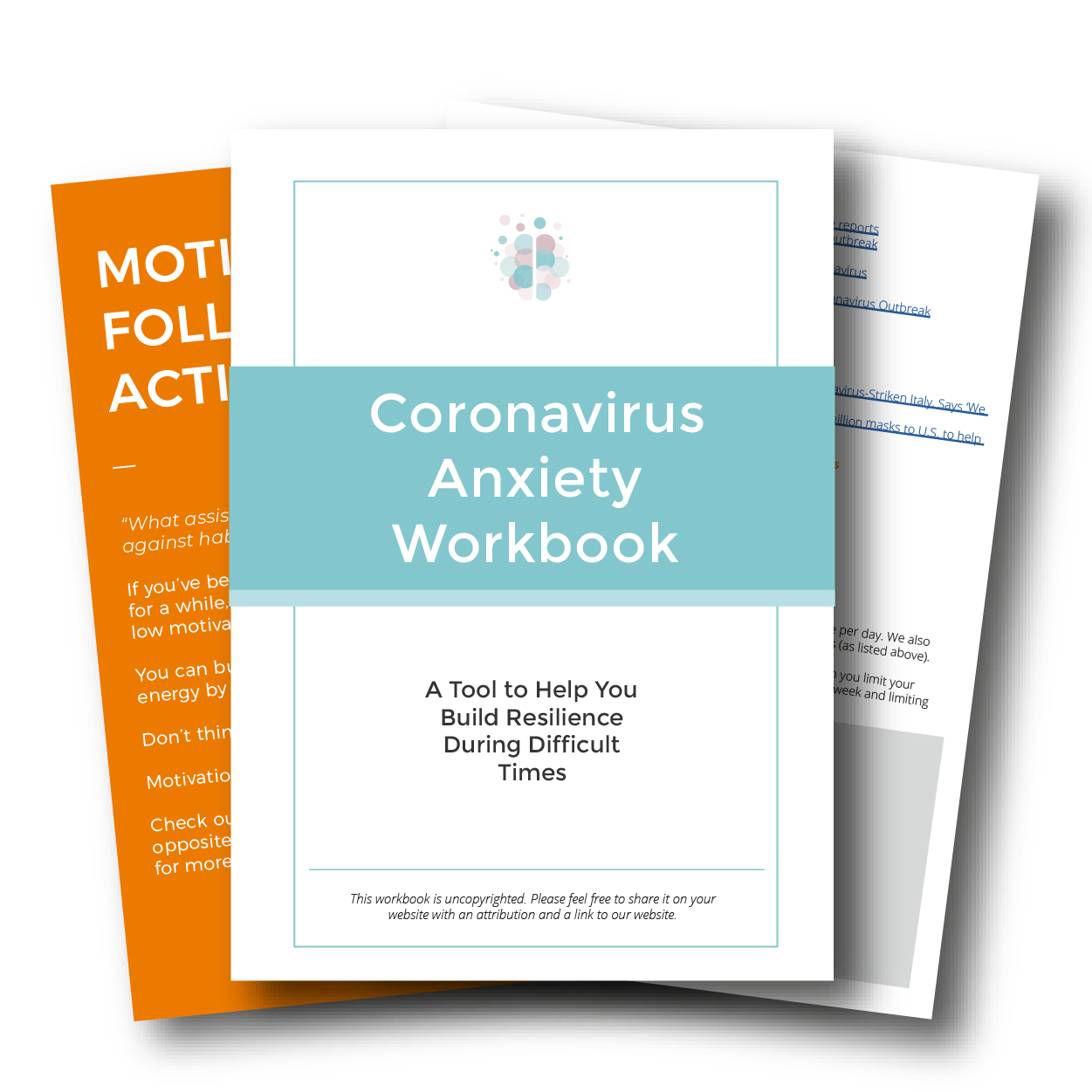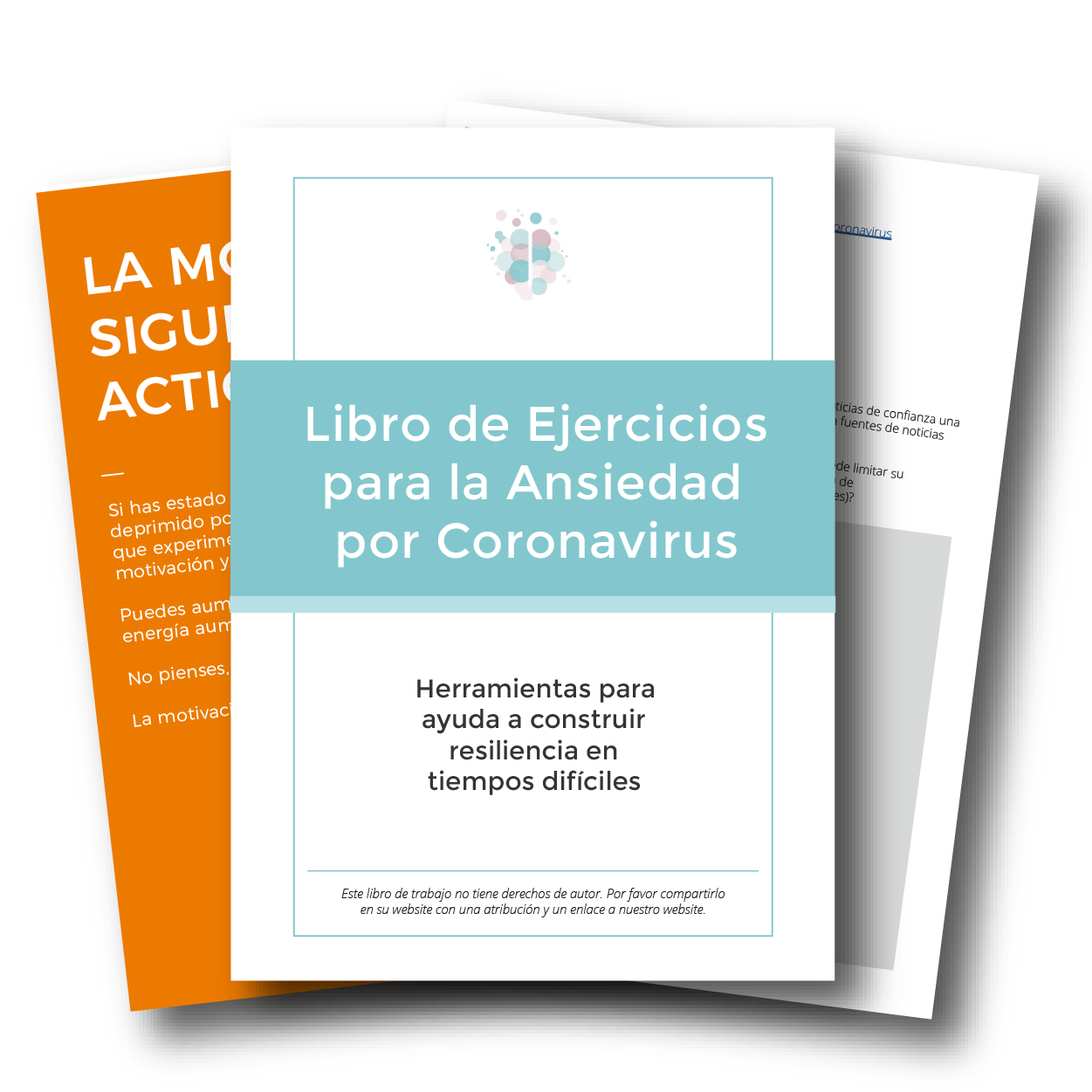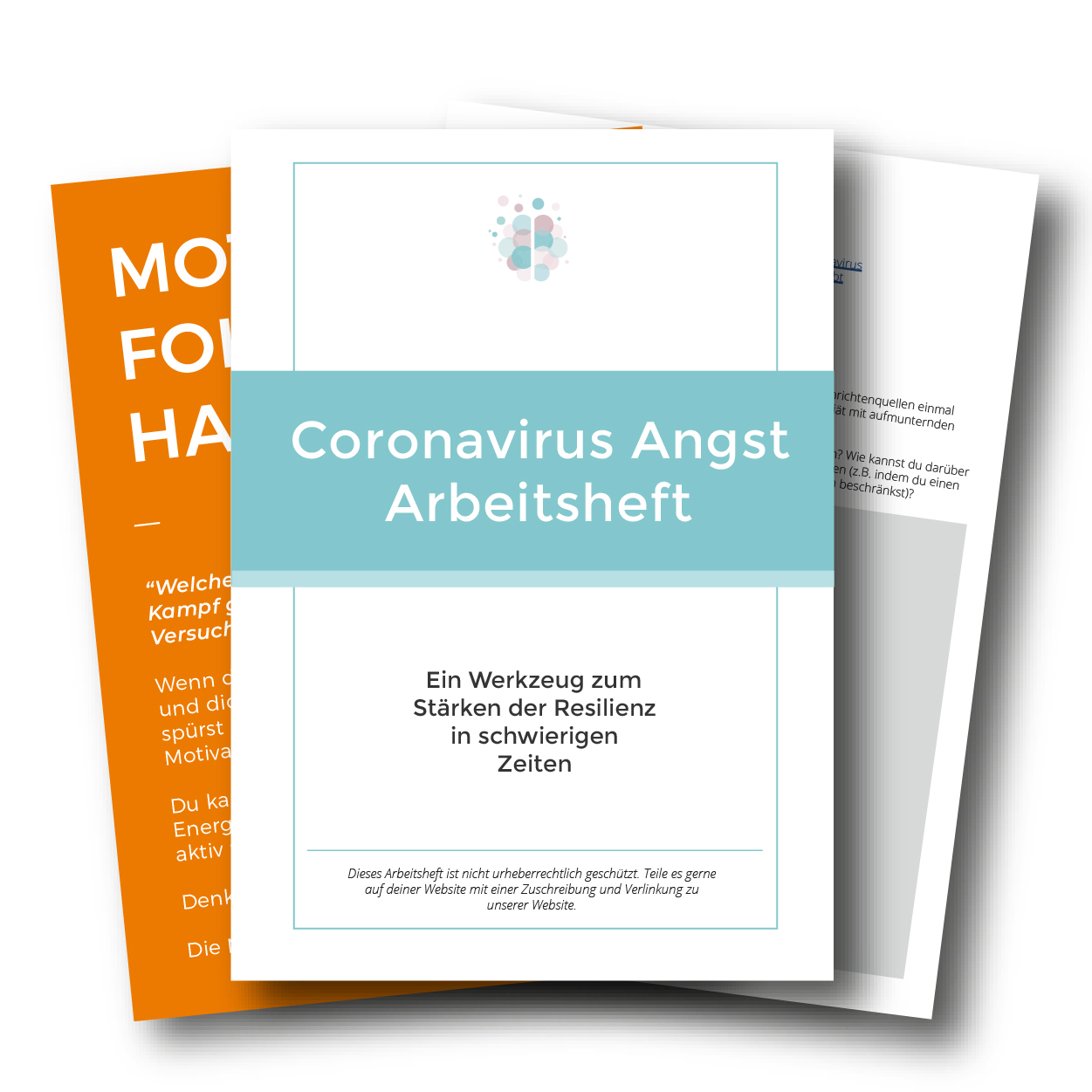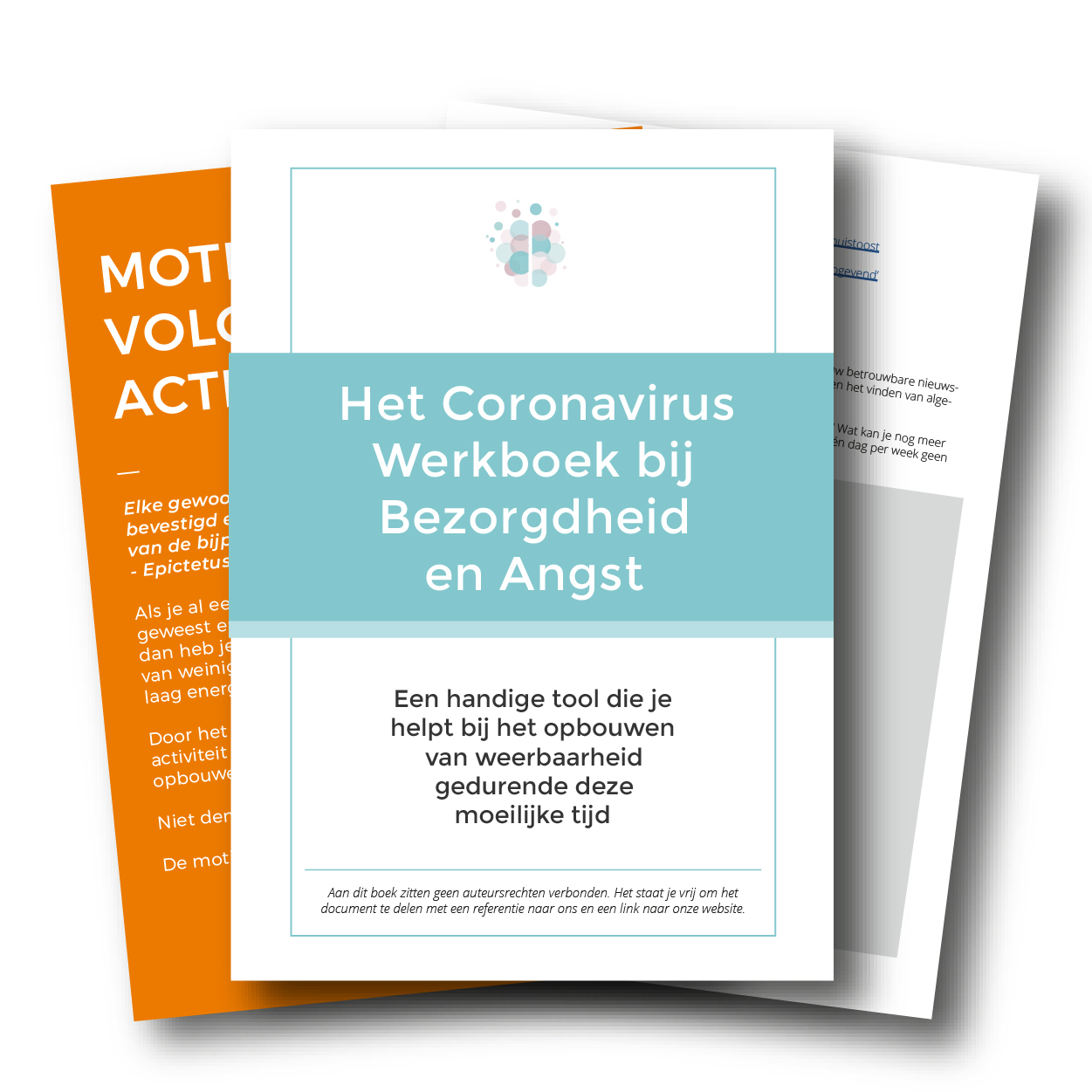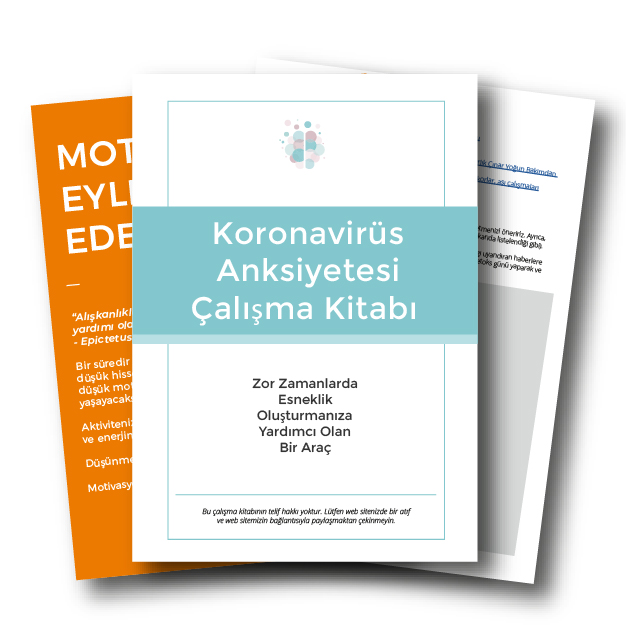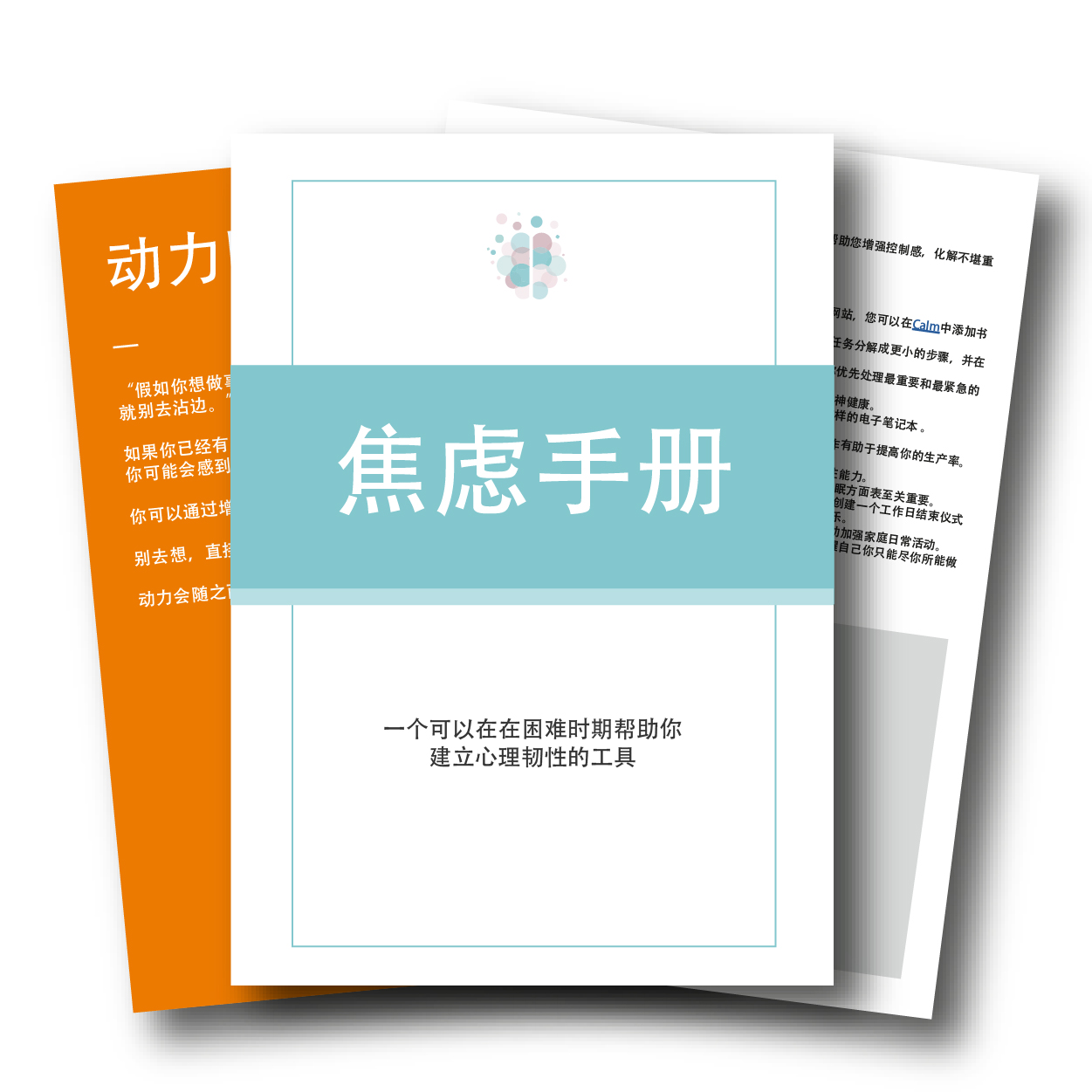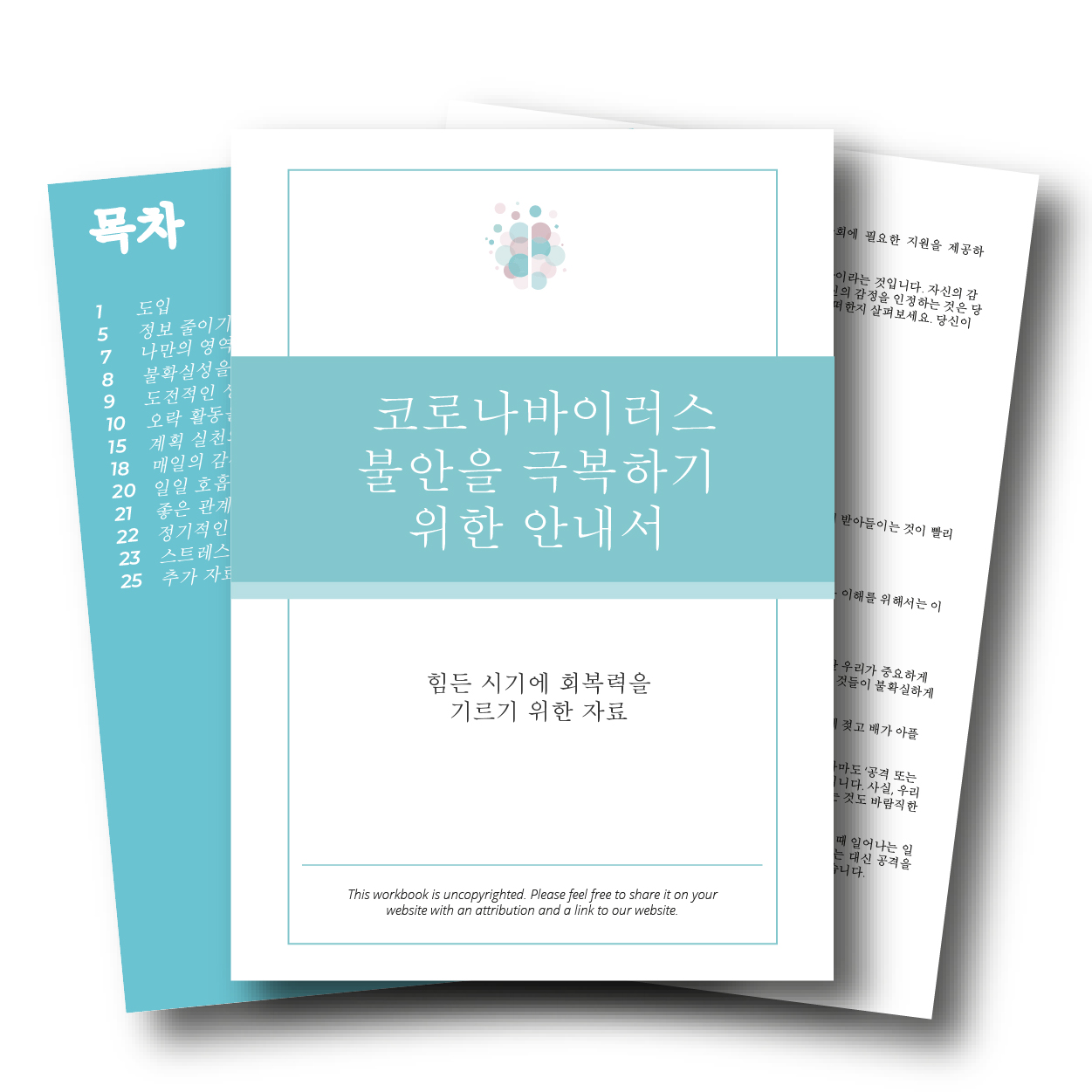Join our mailing list to receive future updates direct to your inbox
Introduction
In this unprecedented period of global uncertainty, we felt it was necessary to put together a COVID anxiety workbook to provide our community with much needed support. This is an online version of the PDF workbook which you can download for free above.The first thing to note right now is that it’s completely normal to be experiencing a wide range of emotions. Accepting your feelings is an important first step to building resilience. The simple act of naming your emotions has been found to benefit wellbeing. So, take a moment now to tune into your body and notice how you’re feeling. You may be feeling:
- Anxious
- Stressed
- Worried
- Fearful
- Low
- Lonely
- Overwhelmed
- Helpless
- Frustrated
- Guilty
- Angry
What Is Stress and Anxiety?
The terms stress and anxiety are often used interchangeably. To develop a deeper understanding of mental wellbeing, it’s helpful to understand how they differ.Stress
Kelly McGonigal, an expert in the new science of stress, offers us this definition: “Stress is what arises when something we care about is at stake”. Many of us are now in positions where things that matter to us feel more uncertain, which understandably gives rise to our stress response.Stress is best understood as manifesting in the body. It’s the racing heart, sweaty palms and funny tummy we’re all familiar with. Central to the experience of stress is the amygdala, the area of your brain responsible for generating your body’s stress response.
Experts agree that a core component of stress is the perception of threat and danger. You’ve probably heard of the ‘fight-or-flight’ stress response as a reaction to perceived danger. In fact, we have various stress responses. For example, there is one response which encourages us to reach out for social support, named the ‘tend and befriend’ response.
Dr John Arden, author of several books integrating neuroscience and psychotherapy, recently put forward the term autostress for describing what happens when our body’s stress response goes on for a long time. He explains:
“Like autoimmune disorders that hijack the immune system, attacking the body instead of protecting it, autostress [transforms] the stress response system into something that attacks the self rather than protecting it.”
If your body is in autostress mode, you’ll experience a wide range of physical stress symptoms on an ongoing basis, regardless of your situation. That’s why people often reporting feeling anxious for no apparent reason. If you’re suffering from high levels of distress triggered by the pandemic, you might continue to feel this way after the virus has passed.
Signs of autostress include:
- Chest tightness and feeling like you can’t breathe
- Muscle tension, aches and pains
- Headaches
- Difficulty sleeping
- Restlessness and an inability to relax
- Heart palpitations
- Digestive issues
Anxiety
Anxiety is commonly described as having both mental and physical symptoms. The distinction between mental and physical anxiety is important because different tools are required for addressing physical symptoms (what we label autostress) and mental symptoms (what we label anxiety).Anxiety is best described as the unhelpful thinking patterns we experience when our mind fixates on threat, uncertainty and negativity.
Anxiety can occur on its own, as a response to stress, or it can trigger stress. When it occurs as a response to stress, it can intensify the stress, and, in worst cases, lead to panic attacks.
It’s important to understand that you cannot control anxiety from occurring – this is your brain’s automatic survival mechanism. What matters is learning how to respond to anxiety helpfully, so that you don’t get carried away by it.
Here are five examples of what to look out for with COVID anxiety:
Threat Scanning
When your mind searches the environment for what you fear (consciously or subconsciously). Threat scanning is often associated with your mind assigning meaning to harmless events.Examples
- Frequently checking your body for coronavirus symptoms.
- Obsessively checking the news for coronavirus updates.
Catastrophising
When your mind jumps to worst case scenarios, i.e., ‘making a mountain out of a molehill’.Examples
- You feel chest tightness and your mind tells you that you have coronavirus and that your life is in danger.
- Your mind gives you the mental image of losing all the people you love.
Hypothetical Worry
It’s important to note that worry is completely normal. It only becomes unhelpful when you focus excessively on hypothetical worries instead of practical worries. Hypothetical worries include ‘what if’ thoughts and are typically about things you don’t have much control over. Practical worries concern things you do have control over, and they can help you be more proactive.If you’re very uncomfortable with uncertainty, you’re likely prone to hypothetical worry and spend a lot of time focused on the future instead of the present.
Examples
- “I know I’m following all the guidelines, but what if I spread the virus?”
- “What if someone gets too close to me at the supermarket and I catch it?”
Emotional Reasoning
When your mind tells you that your emotions reflect reality. While emotions can act as helpful messengers, they often aren’t reliable.Examples
- “I feel scared, so I must be in danger.”
- “I feel guilty, so I must’ve done something wrong.”
Fortune Telling
When your mind interprets predictions as facts.Examples
- “I’m going to be stuck inside for months on end.”
- “My mental health will keep deteriorating and I’ll have to go back on meds.”
Learning how to recognise and reduce anxiety is an extremely helpful life skill.
In Part One of the workbook, we introduce you to several tools for dealing with anxiety.
Part Two is designed to help you create your Stress Resilience Action Plan for preventing and reducing autostress.
Part One: Tools to Help You Manage COVID Anxiety
Planning Your Information Diet
The media is fully aware that our brains are built to fixate on threat, uncertainty and negativity – and they capitalize on it. Most news sources are negatively biased, sensationalist and speculative in order to win your attention. Coronavirus anxiety is easily fuelled by consuming this kind of information. To reduce anxiety, it’s important to be aware of and take control over your information diet.Which information sources are you feeding your mind and how often?
Key Coronavirus Facts
If you’re prone to catastrophising, you may find it helpful to redirect your attention to the facts:- The vast majority of people only experience relatively mild symptoms.
- Coronavirus is fatal in about two to three percent of cases.
- Health advice for the public is as follows:
- Wash your hands with warm water and soap for at least 20 seconds:
- After coughing or sneezing
- Before, during and after you prepare food
- Before eating
- After toilet use
- When you get in from the outdoors
- When hands are visibly dirty
- When caring for the elderly or sick
- After handling animals or animal waste
- Use alcohol-based hand sanitizers as a substitute for washing your hands, but do so sparingly.
- Maintain a distance of at least 2 metres (6ft) between yourself and anyone who is coughing or sneezing.
- Cover your coughs and sneezes and throw your tissue into a closed bin immediately after use.
- Avoid touching your eyes, nose and mouth.
- Frequently disinfect surfaces, like your desk, phone, tablet, smartphone, and countertops.
Trusted News Sources
We recommend finding and sticking to a credible source you can trust, such as:Uplifting News Sources
- Coronavirus chronicles: Here’s some good news amid the dire reports
- Coronavirus: Creativity, kindness and canals offer hope amid outbreak
- Positive News Amongst Coronavirus Outbreak
- Italian 101-year-old leaves hospital after recovering from coronavirus
- 98-year-old COVID-19 patient discharged from hospital
- 32 Positive News Stories You May Have Missed During The Coronavirus Outbreak
- Uplifting stories from New York Times
- Positive News Magazine
- Uplifting stories from BBC News
- German firm Bosch to cut coronavirus test time ‘to 2½ hours’
- Chinese Company Donates Tens of Thousands of Masks to Coronavirus-Striken Italy, Says ‘We Are Waves of the Same Sea’
- China’s richest man to donate 500,000 coronavirus testing kits, 1 million masks to U.S. to help ‘in these difficult times’
Good News Newsletters
To reduce coronavirus anxiety, we recommend checking your trusted news source once per day. We also recommend balancing out your information diet with uplifting news sources (as listed above).
Which news sources will you use and when will you read them? How else can you limit your exposure to anxiety-provoking news (e.g., by doing one digital detox day per week and limiting time on social media)?
My Spheres of Influence
If you’re prone to hypothetical worry (i.e., the ‘what if?’ thoughts), you may find it helpful to practice noticing these thoughts and then redirecting your attention to things within your control.Research shows that when we shift our focus to what we can control, we see meaningful and lasting differences in our wellbeing, health, and performance.
Remember: You cannot stop hypothetical worries from occurring, but you can control your response to them.
|
Within My Control |
Outside My Control |
|
Building resilience Following the latest information and advice Focusing on what’s important to me My information diet My routine Relaxation Cultivating connection Eating well Exercising Seeking and offering support Voting and activism |
Other people’s decisions Other people’s health The news The government’s actions Schools opening or closing The state of the healthcare system Flights and holidays being cancelled Traffic Public transport Aging The weather |
Practical Wisdom for Tolerating Uncertainty
People who experience anxiety have been shown to have a low tolerance for uncertainty. It’s worth reminding ourselves that uncertainty is an inescapable part of life, and the sooner we become more comfortable with it, the sooner we can reduce mental suffering.Stoic and Buddhist philosophy both emphasise embracing uncertainty and change as the essence of life. Many people find reading about these topics helpful, stating that practical wisdom helped them shift their mindset and reduce anxiety.
Videos
Books and Audiobooks
- Happy by Derren Brown - Listen to this for free on Audible using their 30 day free trial
- Philosophy for Life by Jules Evans
- Meditations by Marcus Aurelius
- Letters from a Stoic by Seneca
- Buddhism Plain and Simple by Steve Hagen
Quotes
“The greatest obstacle to living is expectancy, which hangs upon tomorrow and loses today. The whole future lies in uncertainty: live immediately.” – Seneca
“Ask yourself: Does this appearance (of events) concern the things that are within my own control or those that are not? If it concerns anything outside your control, train yourself not to worry about it.” – Epictetus
“You have power over your mind, not outside events. Realize this and you will find strength.” – Marcus Aurelius
“When you arise in the morning, think of what a precious privilege it is to be alive - to breathe, to think, to enjoy, to love.” – Marcus Aurelius
“When I see an anxious person, I ask myself, what do they want? For if a person wasn’t wanting something outside of their control, why would they be stricken by anxiety?” – Epictetus
“The universe is change; our life is what our thoughts make it.” – Marcus Aurelius
“It’s not what happens to you, but how you react to it that matters. When something happens, the only thing in your power is your attitude toward it; you can either accept it or resent it.” – Epictetus
“Men are disturbed not by things, but by the view which they take of them.” – Epictetus
“Don’t demand or expect that events happen as you would wish them do. Accept events as they actually happen. That way, peace is possible.” – Epictetus
“Don’t let your reflection on the whole sweep of life crush you. Don’t fill your mind with all the bad things that might still happen. Stay focused on the present situation and ask yourself why it’s so unbearable and can’t be survived.” - Marcus Aurelius
“Freedom and happiness are won by disregarding things that lie beyond our control.” – Epictetus
Reducing COVID Anxiety With Thought Challenging
Thought challenging is a simple yet powerful cognitive behavioural therapy (CBT) technique for reducing coronavirus anxiety.As mentioned, anxiety is best described as the unhelpful thinking patterns you experience when your mind fixates on threat, uncertainty and negativity. Thought challenging helps by broadening your focus to include the bigger picture.
Below are two thought challenging techniques you can experiment with. Keep practicing and discover what works best for you.
The ABCDE Technique
Attention – When you feel distressed, stop what you’re doing and pay attention to your inner dialogue. What is your mind telling you?Believe? – Do not automatically believe your thoughts!
Challenge – Defuse anxiety by broadening your focus. What’s the bigger picture? Is the thought fact or opinion? What might you think if you were feeling calmer?
Discount – Acknowledge that anxiety has been is dominating your thinking and let the unhelpful thoughts go.
Explore options – What would be helpful to focus on right now? What options do I have available?
The THINK Technique
True? – Is this thought 100% true? If not, what are the facts, and what is opinion?Helpful? – Is paying attention to the thought useful to me or others?
Inspiring? – Does the thought inspire me or does it have the opposite effect?
Necessary? – Is it important for me to focus on the thought? Is it necessary to act on it?
Kind? – Is the thought kind? If not, what would be a kinder thought?
Thought Challenging Tips
- Writing or typing your thought challenging process is more powerful than trying to do it in your head. We recommend trying out the free CBT Thought Diary app (Google Play, iTunes).
- If you’re not used to paying this much attention to your inner dialogue, thought challenging might feel unnatural at first. That’s okay. Over time, it’ll start to feel easier.
- This isn’t the most appropriate tool if you’re feeling very distressed, as it can be hard to think rationally when your emotional brain has taken over. Try defusing your emotions with a distraction activity (see the following page) and returning to thought challenging once you’re feeling calmer.
Reducing COVID Anxiety Through Distraction Activities
If your mind continues to spiral with unhelpful thoughts, distraction can be an effective tool for nipping it in the bud. It’s important to note that a distraction activity must be very attention absorbing to effectively reduce coronavirus anxiety. When an activity isn’t working well, spend some time reflecting on why this could be and how you could make it more attention grabbing in future.Distraction activities have the added benefit of helping you feel happier, more motivated and more energised, as well as combatting feelings of boredom.
Low activity and social disconnection are the two most fundamental maintaining factors of low mood, motivation and energy.
To feel better through building up your drive system (see page 8 of our Understanding Your Mental Wellbeing Guide), you need to increase your activity levels and ensure you’re meeting your social connection needs (which we’ll address later).
Here’s a list of 74 ideas for healthy distraction activities:
1. Browse mindfulness and meditation resources to try - find lots in our online guide!
2. Work on personal development through journaling - here’s a list of prompts
3. Browse new healthy recipes
4. Plan your meals
5. Work your way through this list of films that have helped people with their mental health
6. Do the 7 Day Happiness Challenge from Action for Happiness
7. Watch free online documentaries
8. Watch comedy
9. Play on a trivia or games app
10. Learn some basic yoga poses - we recommend Yoga with Adriene on YouTube
11. Learn calligraphy or hand-lettering
12. Learn how to play a musical instrument
13. Talk to a volunteer listener (see pages 20-26 of The Social Connection Planner)
14. Read a biography about someone who inspires you
15. Do some mindful colouring - check out our free mindful colouring sheets
16. Rediscover old music you liked when you were a teenager
17. Watch a live stream theatre show from The National Theatre
18. Make a list of things to save up for
19. Have a relaxing DIY foot soak
20. Do a free online nutrition course
21. Start a blog
22. Download Bumble BFF and chat to new people in your area
23. Reorganise or redecorate your living space
24. Do a jigsaw puzzle
25. Make a list of goals for the year
26. Find a new podcast to listen to
27. Declutter
28. Update your CV
29. Make a list of books you want to read this year
30. Search Pinterest for craft or DIY project ideas
31. Download Reddit and browse uplifting content such as r/aww and r/humansbeingbros
32. Do a free online drawing class
33. Search Facebook for local groups with volunteering opportunities
34. Arrange to catch up with someone over video chat
35. Explore new music
36. Do a workout video
37. Brainstorm ways to save more money
38. Learn furniture building or upcycling
39. Make a life experiences bucket list
40. Get a 30 day free trial of Audible and listen to an audiobook
41. Do a free online coding course
42. Build your Mental Wellbeing Toolkit
43. Use Jackbox Games to play games with friends
44. Join an online book club
45. Start learning a new language
46. Do the 4-week Best Possible Self Exercise, an evidence-based intervention for improving wellbeing
47. Plan some thoughtful birthday or Christmas gifts
48. Research activities for your elderly relatives
49. Start a side project to earn extra money
50. Browse free online courses (here are some for kids)
51. Write a poem or short story
52. Make a cookbook of your favourite recipes
53. Make a list of things you’re looking forward to when the pandemic is over
54. Become a volunteer listener (or chat to one) on 7Cups.com
55. Watch a live stream gig from Sofar Sounds
56. Watch TED Talks
57. Use the Netflix Party extension to watch Netflix with your friends online
58. Do a home improvement project
59. Do some gardening
60. Make a list of topics you’re curious about and research them online
61. Do a spring clean
62. Search Pinterest for family bonding ideas
63. Search Pinterest for indoor kids activities
64. Learn knitting, cross-stitch or embroidery
65. Find a new board game to play
66. Do exercise song videos with your kids
67. Take part in a virtual pub quiz
68. Start a dream journal
69. Watch a live opera stream from The Metropolitan Opera
70. Do somebaking
71. Feel more connected by finding a pen pal
72. Learn how to invest in this free online course
73. Explore ideas for camping in your backyard
74. Browse our free tools library!
Part Two: Creating Your Stress Resilience Action Plan
Here are five different methods for preventing and reducing physical anxiety symptoms (i.e., autostress).Choose the practices that appeal most to you and add them your Stress Resilience Action Plan.
(The more, the better!)
Starting a Planning Practice
Maintaining structure can work wonders for your mental wellbeing. Routines help you increase your sense of control and defuse feelings of overwhelm.Planning Tips
- Schedule regular breaks. Take time to mindfully drink your tea or focus on your breathing – here’s a great website you can bookmark from Calm.
- Write a weekly goals list. Identify what you need to do to achieve your weekly goals. Break tasks down into smaller steps and cross them off as you go to maintain a sense of progress throughout the day.
- Identify 1-3 “Most Important Tasks”. Creating a daily MIT list helps you prioritize your most important and urgent tasks.
- Review your crossed off items at the end of the day. Taking stock of your achievements can help boost mental wellbeing.
- Try a to do list app. You may prefer a digital format such as Google Keep.
- Experiment with productivity techniques such as The Pomodoro Technique and Eat The Frog.
- Write your daily to do list the night before. You might find that being able to start work straight away helps increase your productivity. Also, this practice can help you clear your mind and switch off in the evening.
- Tidy your workspace at the end of the day. Research finds that cluttered environments interfere with your ability to focus.
- Decide on a regular sleep schedule. When it comes to improving sleep, research suggests that maintaining a regular sleep schedule is of high importance.
- Create an end of work day ritual. To enforce work-life boundaries, you might find it helpful to create an end of day ritual such as changing into comfier clothes, switching off work email notifications and putting on some music.
- Create weekly family traditions. Strengthen family routines through traditions such as “Board Game Fridays” and “Movie Night Mondays”. Find more advice and resources for setting up a family routine here, here and here.
- Be kind to yourself. You might suddenly have a lot more on your plate. Be mindful of your inner critic, and remind yourself that you can only do the best you can.
Starting a Daily Gratitude Practice
“Enjoy the little things. For one day you may look back and realize they were the big things.” – Robert Brault
Research shows that cultivating gratitude has a plethora of benefits, including:
- Reducing stress and anxiety
- Boosting mood
- Strengthening your immune system
- Improving sleep
A simple way to cultivate gratitude is to keep a gratitude log. Each day at a set time in your daily routine, write down one thing you’re grateful for on the gratitude log sheet.
Starting a Daily Breathing Practice
Breathing difficulties are associated with autostress. When you have problems with your breathing, you lower the amount of carbon dioxide that’s normally in your blood. This leads to a wide range of symptoms, including:- Shortness of breath
- Chest tightness
- Tingling or numbness in the arms, fingers, toes, or around the mouth
- Feeling dizzy and light-headed
- Weakness
- Heart pounding and racing
- Heart palpitations
- Sweating or hot flushes
- Headaches
- Feeling sick
- Fatigue
Your breathing difficulties may be related to:
- Shallow breathing (breathing in too quickly)
- Over-breathing (breathing in more air as you feel like you’re not getting enough, for example through yawning or sighing frequently)
Some people experience both.
So, let’s take a moment to test your breathing:
- Put one hand on your chest, and one on your belly.
- Breathe for a few seconds. Which hand rises?
- If it’s your chest, you might have developed a habit of shallow breathing.
Although the effects of shallow breathing can be very unpleasant, it won’t harm you, and you can reverse the habit with a daily breathing practice. The next time you feel anxious, take a moment to notice your breathing. Focus on breathing through your stomach so that your belly rises when you inhale and drops when you exhale.
Here’s a belly breathing exercise you can practice for 5-10 minutes a day:
- Inhale gently, lightly and slowly count to four, expanding your belly as you do so,
- Hold that breath for a count of two,
- Slowly exhale though your mouth for a count of six.
Improving the Quality of Your Social Connections
How to cultivate connection in a period of isolation?Here are some ideas you can add to your Stress Resilience Action Plan:
- Use the online support resources listed in page 7 of The Social Connection Planner.
- Explore improving your communication skills using pages 12-14 of The Social Connection Planner.
- Talk to volunteer listeners on a helpline (see pages 20-26 of The Social Connection Planner).
- Use this time as an opportunity to complete the Relationship Inventory Exercise (see page 27).
- Schedule video chat catch ups with friends you haven’t spoken to in a while.
- Use the video chat app Houseparty to play popular games like trivia and Heads Up! with friends.
- Have a virtual happy hour over video chat.
- Browse Meetup.com for events that have been transferred to online.
- Organise a weekly lunch date with a friend over video chat.
- Use the Netflix Party extension to watch Netflix with your friends online.
- Send letters to your loved ones using a service like Postable.
- Play Scrabble and chat to friends using the Words with Friends app.
Here’s a list of 17 video chat options.
Developing a Regular Exercise Routine
“Walking is man’s best medicine.” - Hippocrates
Exercise reduces the overall activation of your amygdala and sympathetic nervous system – the parts of your brain and body that generate your stress response.
Research suggests that aerobic exercise (such as walking, cycling, and jogging) provides the same benefits as non-aerobic exercise (such as yoga and pilates).
Studies also suggest you need around 21 minutes three times a week to experience the benefits. So, you don’t have to spend hours doing it – it’s something most of us can fit in to our lives when it becomes a priority.
It’s important to find something that you enjoy when it comes to building an exercise habit. Now more people than ever are interested in fitness, you have endless options. These include ‘bedroom fitness’ resources and tools that make it easy to keep moving indoors.
Here are some ideas you can add to your Stress Resilience Action Plan:
- Schedule a daily walk.
- Complete YouTube video workouts.
- Do a free trial of Les Mills at home workouts.
- Do online yoga with Yoga with Adriene.
- Do the 5 week strength and flexibility plan from the NHS.
- Set yourself a challenge to run 5k with the support of the couch to 5k running plan for beginners.
- Invest in some indoor exercise equipment.
- Do this 10 minute home cardio workout from the NHS.
- Find an outdoor gym to visit.
- Browse Pinterest for indoor workouts.
- Do an affordable at home cardio workout with a jump rope.
- Invest in a Fitbit to track your progress.
Don’t forget: Motivation follows action!
COVID Anxiety Further Resources
“Don’t be ashamed of needing help. You have a duty to fulfil just like a soldier on the wall of a battle. So what if you are injured and can’t climb up without another soldier’s help?”- Marcus Aurelius
There are endless ways to improve your mental wellbeing and an abundance of tools to support you.
This time may represent an excellent and rare opportunity for you to invest in yourself and develop skills that will help you for the rest of your life.
Here are some recommended resources for coronavirus anxiety:
- The free online course Coping during the pandemic from Recovery College Online (click log in as guest)
- Coronavirus Anxiety - Helpful Expert Tips and Resources from the ADAA
- The free e-Book FACE COVID: How to respond effectively to the Corona crisis by Dr Russ Harris
- Free Guide To Living With Worry And Anxiety Amidst Global Uncertainty from Psychology Tools
- The Framework, our deeper dive into understanding, transforming and reducing stress, autostress and anxiety
- The Mental Wellbeing Toolkit, our comprehensive set of practical tools designed to help you improve your mental health and wellbeing
- Our online guide to accessing therapy. There are many therapists currently working via video chat. If you start to feel too overwhelmed emotionally or physiologically, we strongly encourage you to seek the support of a trained professional
Join our mailing list to receive future updates direct to your inbox
Pin For Later
